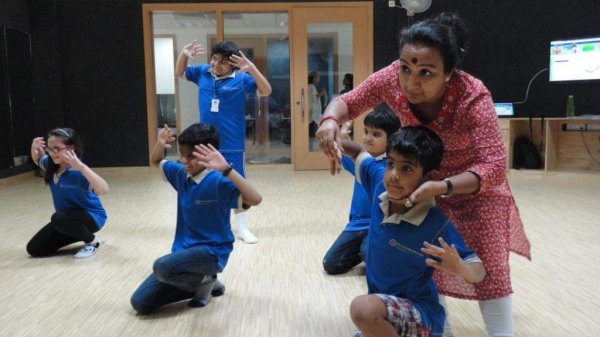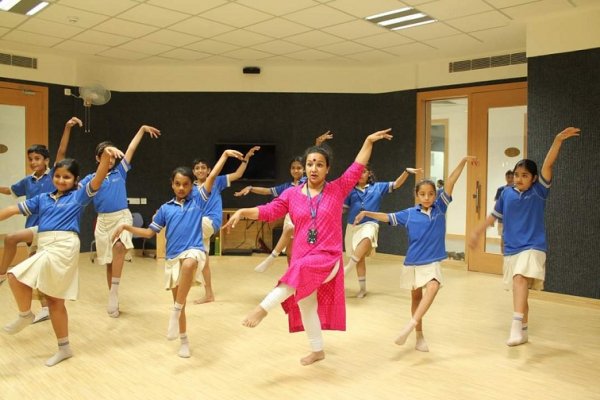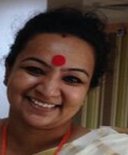
|
 |

|
 |
Stage to Classroom Importance of dance education in schools - Dr. Parul Purohit Vats e-mail: preciousparul79@gmail.com January 14, 2021 Dha Dha Dhin Ta... A powerful entry of the dancer on stage, amidst bright lights. Opening with speed but also restraint. Followed by Vandana to connect, the dancer and the audience, with the divine. Then one after the other the audience marvels at numerous technical pieces introduced with padhant and filled with intriguing footwork, flawless pirouettes and complex rhythmic patterns. The sound of ghunghroos, high energy level and the crescendo builds up in drut laya. A round of applause every time the dancer executes lightning fast footwork, numerous chakkars or any piece executing the evolved technique of Kathak. The performance is concluded with a splendid abhinaya (expressional) piece leaving the audience in complete awe of the dancer and the dance style. This was a regular scene from my life as a performer on stage. Venues and concepts changed but the thrill remained the same year after year. But there comes a time in every dancer's life, a time to reflect inwards and reckon, what next from here. Not that I was tired of performing, I still perform quite a lot but yes, I was yearning for more.  I observed over the years as a performer that the number of audience in classical dance shows was decreasing day by day. I realized that probably because dance isn't a part of the formal education system as a proper subject, thus the rich history and heritage is something that children never get to know of. There is no dearth of dancers but indeed of an audience who understands dance. Not dance alone, or items, but dance education its nuances, its spiritual feel and its layered approach. And what better place to introduce the rich cultural heritage of our dance forms than the regular educational set up. So I decided to take the plunge and joined a school as a dance teacher. However, I faced a lot of criticism for the same as many a fellow dancers and my teachers felt that it was degrading myself. Stepping down from the stature of a star performer to a mere school teacher? This was one of the many snobbish comments I received. This also meant a severe drop in my earnings both in the aspect of money and accolades. Teaching classical dance forms in an educational set up can be a highly reflective process for a dancer. The number of students in a school classroom can be anywhere between 25 to 50. It is no hidden truth that a majority of our youngsters, especially boys, are averse or disinterested in learning Indian classical dance forms. There is little chance that the management understands the benefit and importance of structured dance education. The regular stage performances required by students on school functions also adds to the challenge. What irked me the most, in the beginning, was the definition or understanding of classical dance forms that the younger generation had, was mostly from either films or TV shows. Just by keeping few technical compositions in a film song, doesn't make it classical dance. It is almost like devaluing your roots and where you come from. It's a short cut and it teaches the next generation that you can devalue your work in order to progress fast. Dilution of the form should not happen, half-baked dancers with no knowledge or understanding of the form, moving to funky songs in classical dance style, completely destroys the authenticity and purpose of our traditional dances. The necessity was that people with a deep rooted understanding of the form, deconstructs, researches, re-interprets to reach out to more people through public medium. Regardless of all the challenges, teaching dance in regular schools has been an equally satisfying experience for me, just like performing on stage. It is a balancing act of constant planning and reviewing to meet students' needs according to their ability to absorb the content. This in return strengthens the knowledge and skills of the teachers also. When a professional dancer or dance studio teacher joins a regular school they enhance the level of dance education in that particular set up because of their competency in the art form. However, they have to bring a paradigm shift in their teaching approach and methodology. Apart from my personal experience, talking to various dance educators who are simultaneously teaching in dance institutions as well as regular schools further clarified this difference. If one decides to become a dance teacher in formal educational set up then it is imperative to understand the basics of being a dance educator. You need to have your grammar correct if you want to write prose and poetry. The education system has undergone a tremendous change in the 21st century and a dance educator's role has also become elaborate. Holistic development of all students is the aim of education systems universally. Nowadays, education is focusing on developing EQ along with IQ of the students. Integrated teaching is the new mantra where all the aspects of students' personalities are developed together. So as a dance educator I had to embrace the cross disciplinary approach which expands, enriches and supports the content knowledge of the discipline.  As Deborah Bull had said, "Young dancers are training at a very vulnerable time in their lives... So train the whole person, not just the dancer." This is a lesson I follow to the T. As dance teacher, I learnt the entire process of planning a lesson and its presentation. One has to plan the outcome of the lesson taught to make certain that it achieves its goal. A suitable approach and method of instruction has to be decided looking at the age group of the learners. Adhering to the principles of teaching, one has to organize teaching points by gauging students' responses at every step. I learnt that planned student participation will keep the class on alert and involved mode throughout the lesson. Overall one learns to teach the nuances of classical dance using the methodology that today's generation can understand. One has to dissect each movement/ syllable/ expression before teaching it to the students and ask herself/himself the weirdest possible questions before entering the class. Over the years, while teaching these young, bright school children, I have personally learnt to just not talk but to communicate with them. Each one of them is an artist in their own way. No two bodies are physiologically the same, thus I have learnt to cater to the uniqueness of each student. I encourage them to be more analytical about the dance piece they are learning. When their knowledge expands, of what's possible choreographically, I also get a deeper clarity of my work. Most of the times, their questions/inputs provide a new perspective to me. I have learnt to evolve each day as I believe in what Aries Spears had said, "To sustain longevity, you have to evolve." Dance has content knowledge of facts, concepts, principles and theories just like any academic subject. It develops self-discipline, perseverance, patience, dedication, concentration and also multi-tasking. These are the skills a student develops for their future, irrespective of their fields. I strongly feel that it is high time that Indian classical dance is introduced as a formal subject in regular schools and not be confined within formal dance institutions. Aesthetics of classical dance has to be introduced to children at a very young age. It will be a great benefit for children at the school level to learn how to hold their spine and use the space around it through learning any one of the Shashtryiya Nritya i.e. classical dance. As art historian and critic Ashish Mohan Khokar puts it, "Young India is an important resource bank. And teaching them properly and competently is the first step." I cannot agree more with him.  Dr. Parul Purohit Vats is a Kathak dancer, educationist, choreographer and art administrator. She has worked closely with teachers in various educational institutions for developing children through dance, as a teacher trainer and also imparted training in Kathak dance there. She was awarded her Ph.D degree for her research on the relationship between Krishna, Thumri and Kathak, in 2008. Post your comments Pl provide your name and email id along with your comment. All appropriate comments posted with name & email id in the blog will also be featured in the site. |